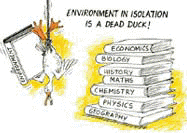 |
|
|
|
Mistaking
the woods for the trees
Somewhere we as a society have failed to grasp that environment goes beyond pretty
trees and tigers. Does this failure not begin in school itself? A failure of perception
that, by the time the child moves into college, is too firmly ingrained in his/her mind? A
willful, if unconscious, misreading of what environment entails? Environmental (read
development) issues are not a matter best left to either 'environmentalists' or the
'concerned rich'. It's everybody's concern, for we all live in and with it.
Environment Education is not extra curricular!
EE has 'evolved' from being a 'fashionable extra curricular' topic to one which is
so vital that unless the young don't understand it enough to make informed choices, our
future existence is in question. Environment education should today go beyond just trees
and wildlife into issues like inequity and poverty, development patterns, lifestyles, and
the governance system.
What? Another subject?
The teacher and the student are already overburdened. It is thus critical to
understand that environment education is not another subject imposed on you. It cannot be
taught as a separate subject. It is inherently inter-disciplinary and can easily be
incorporated into all subjects, be it chemistry, biology, physics, history, geography, or
even languages. |
|
I
teach Civics. How can I be an environmental educator?
You need not specialise in environmental science to be an environment educator.
Environment forms a vital part of each subject (yes, even civics!). Unless we look at it
from all points of view - biological, physical, political, economical, technological,
ethical, historical, spiritual, chemical, social, and so on, we cannot move to a
sustainable future.
They already know the facts. What more do I teach?
Information alone is not enough. The objective of environment education is to move
from awareness to action, and this is not possible by facts alone. The environment
educator should involve the students with multidisciplinary and dynamic deliverance of
these facts, accompanied by activities. Students should be motivated into understanding
and solving real life problems by relating them to environment and the particular subject
through which it is being discussed. G:NET would be just the right tool for this.
 |
|
|
|
|
| The 'green' Century |
The writing on the wall says
technology will be determined by environment |
Few
people realise that the 21st century is going to be the century of the environment.
Technological change is going to be heavily driven by the environmental imperative and
human technologies will be forced to mimic nature's cycles and gentleness.
Why do we say this? Let us look at the evolution of science in the 20th century. At the
start of the century, Einstein and Bohr asked 'What is matter?' By the middle of the
century, scientists were asking: 'What is life?' and 'What is the universe?'
In the 1950s, Watson and Crick unravelled the structure of the DNA, which finally led to
the emergence of biotechnologies today. By the end of the century, another critical
question was asked: 'What is the web of life?'
This last question was not asked out of scientific curiosity but from human
necessity. The vast range of technologies that had emerged because of increased human
understanding of nature was beginning to have major impacts on nature itself. By 1960, it
was difficult to breathe in cities from Tokyo to Los Angeles, and rivers like Rhine and
the Thames turned into stinking sewers.
Technological interventions into natural ecosystems led to major environment surprises.
For instance, CFCs, seen as wonder substances in 1930s, was found to be life-threatening
in the 1970s.
Not surprisingly, a number of emerging technologies are being driven by
environmental imperatives. For example, in the last 20 years, continuous changes took
place in the internal combustion engine because of environmental concerns.
Despite all the environmental efficiency being introduced, as the number of cars grew, and
health effects better understood, the automobile industry was pushed into newer and newer
directions. Car-free cities, which again mean totally new transportaion systems, are being
thought of. Emergence of fuel cells has been driven by the regulation set by the world's
largest car market, California, which has mandated companies to introduce zero-emission
vehicles.
It is clear that in this century, every new technology, even those in biotechnology, will
be forced to take the environmental concern in account… the writing is on the wall.
For us to read. And act.
- Anil Agarwal, Chairperson, CSE |
|

